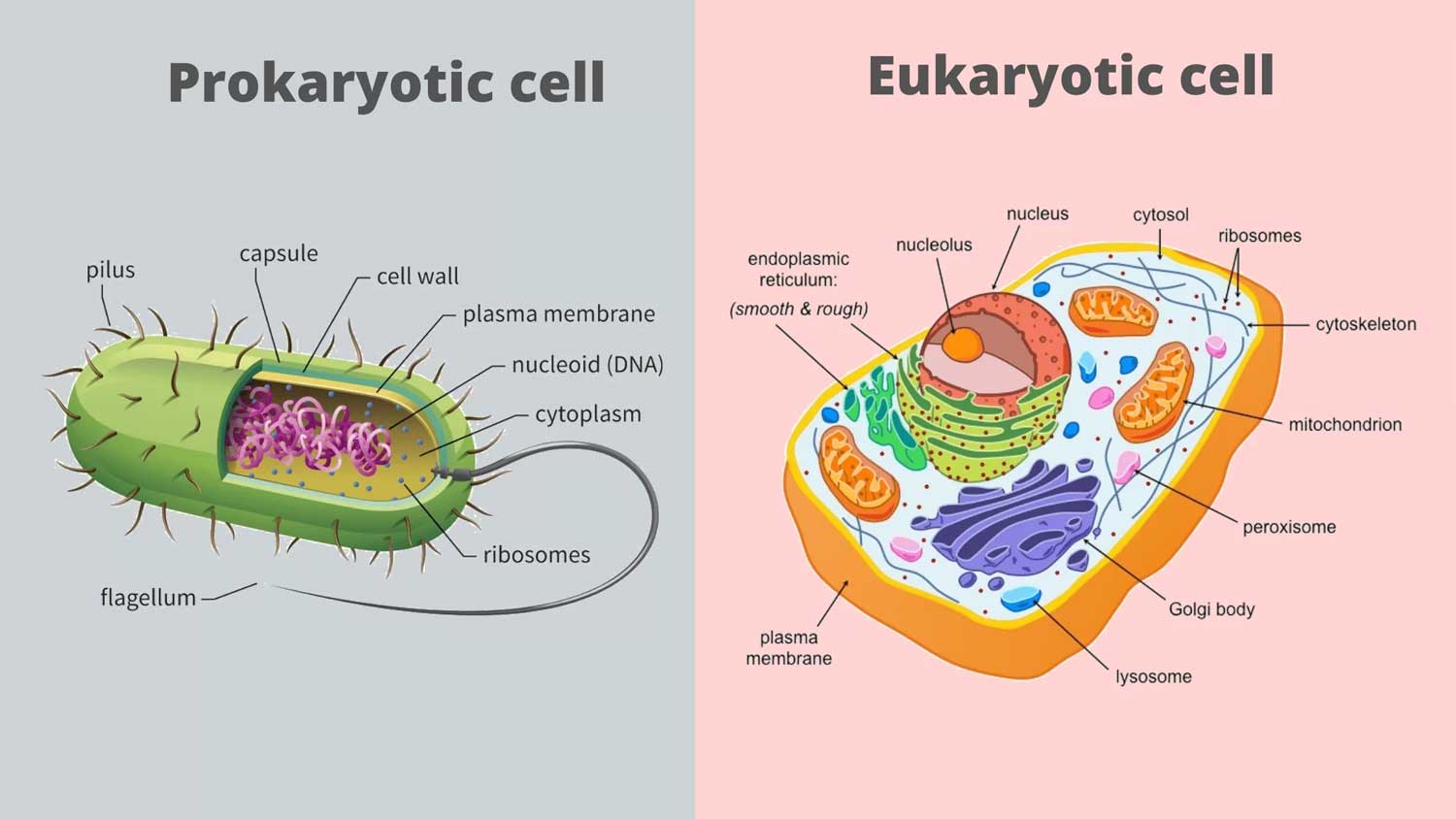Every living organism, from microscopic bacteria to giant-sized animals, falls into one of the two categories – Prokaryotic or Eukaryotic depending on the basis of the type of their cellular structure. In this write-up, we will discuss these two types of cells – Prokaryotic cells and Eukaryotic cells.
Prokaryotic Cell
The term prokaryote has been derived from the combination of two Greek words pro (meaning before) and karyon (meaning kernel). The term together means before nuclei.
Prokaryotic cells are the primitive forms of cells and are characterized by the absence of a nucleus. These are comparatively smaller and much simpler in structure. One of the most defining features of a prokaryotic cell is that it does not contain membrane-bound cell organelles.
Eukaryotic Cell
The term eukaryote has been derived from the combination of two Greek words eu (meaning good) and karyon (meaning kernel). The term together means good or true nuclei.
Eukaryotic cells are such cells that contain true nuclei as well as membrane-bound organelles. These are much larger in size and complex in structure. These cells contain a nucleus that contains DNA embedded with all genetic information. The cell also contains mitochondria that are responsible for the creation of energy to be utilized by the cell.

Differences between Prokaryotic Cells and Eukaryotic Cells
| S. No. | Basis of Difference | Prokaryotic Cells | Eukaryotic Cells |
|---|---|---|---|
| 1. | Type of cell | Prokaryotic organisms are always unicellular. | Eukaryotic organisms are unicellular as well as multi-cellular. |
| 2. | Size | Prokaryotic cells range from 0.2 microns to 2.0 microns in diameter. | Eukaryotic cells range from 10 microns to 100 microns in diameter. |
| 3. | Complexity | Prokaryotic cells are much simpler. | Eukaryotic cells are complex in nature. |
| 4. | Cell wall | Cell walls are usually present in prokaryotic cells and these are chemically complex in nature. | Cell walls may or may not be present in Eukaryotic cells. When present, the cell wall is chemically simple in nature. |
| 5. | Nucleus | The nucleus is absent in prokaryotic cells; instead, there is a nucleoid region in the cell. | The nucleus is present in Eukaryotic cells. |
| 6. | Ribosomes | Ribosomes in prokaryotic cells are spherical in shape and comparatively smaller in size. | Ribosomes in Eukaryotic cells are linear in shape and comparatively larger in size. |
| 7. | DNA | DNA in prokaryotic cells is double-stranded and circular in shape. | DNA in eukaryotic cells is double-stranded and linear in shape. |
| 8. | Endoplasmic Reticulum | Prokaryotic cells do not have any endoplasmic reticulum. | Eukaryotic cells contain endoplasmic reticulum that forms the transportation system of the cell. |
| 9. | Plasmids | Prokaryotic cells have plasmids. | Eukaryotic cells rarely have plasmids. |
| 10. | Lysosome and Centrosome | Lysosome and Centrosome are absent in prokaryotic cells. | Lysosome and Centrosome are present in eukaryotic cells. |
| 11. | Flagella | Flagella in prokaryotic cells are smaller in size. | Flagella in eukaryotic cells are larger in size. |
| 12. | Golgi apparatus | Prokaryotic cells do not have any Golgi apparatus. | Eukaryotic cells have Golgi apparatus. |
| 12. | Cell Division | Cell division in prokaryotic cells happens through binary fission. | Cell division in eukaryotic cells happens through mitosis. |
| 13. | Reproduction | Reproduction in the prokaryotic cell always happens asexually. | Reproduction in the eukaryotic cell may happen asexually as well as sexually. However, sexual reproduction is more common. |
Use the citation below to add this article to your bibliography
"Prokaryotic Cell vs. Eukaryotic Cell: Major Differences." Dashamlav.com. Web. 11 June 2025. <https://dashamlav.com/eukaryotic-cell-vs-prokaryotic-cell/>
Dashamlav.com, "Prokaryotic Cell vs. Eukaryotic Cell: Major Differences." Accessed 11 June 2025. https://dashamlav.com/eukaryotic-cell-vs-prokaryotic-cell/
"Prokaryotic Cell vs. Eukaryotic Cell: Major Differences." (n.d.). Dashamlav.com. Retrieved 11 June 2025 from https://dashamlav.com/eukaryotic-cell-vs-prokaryotic-cell/
